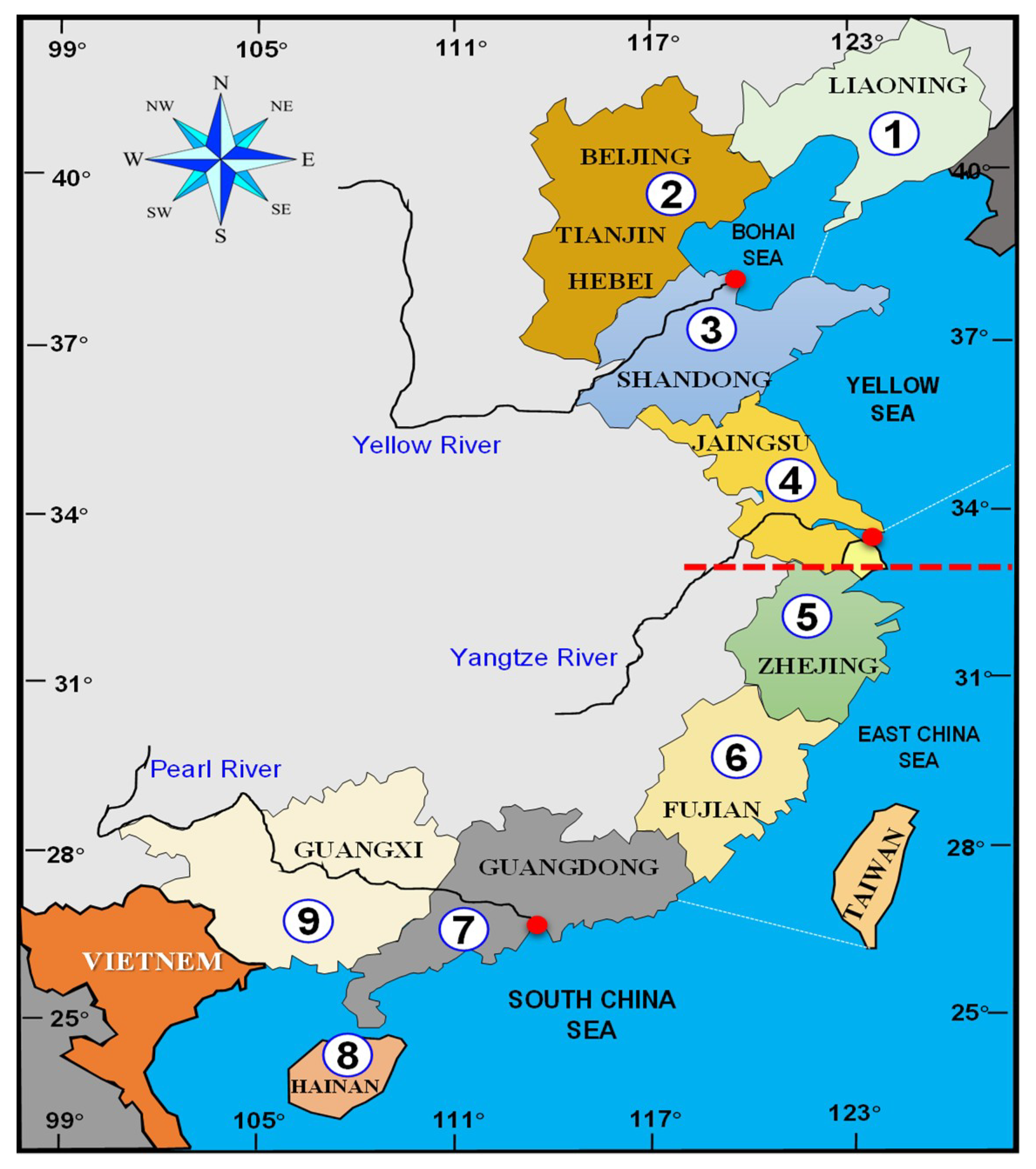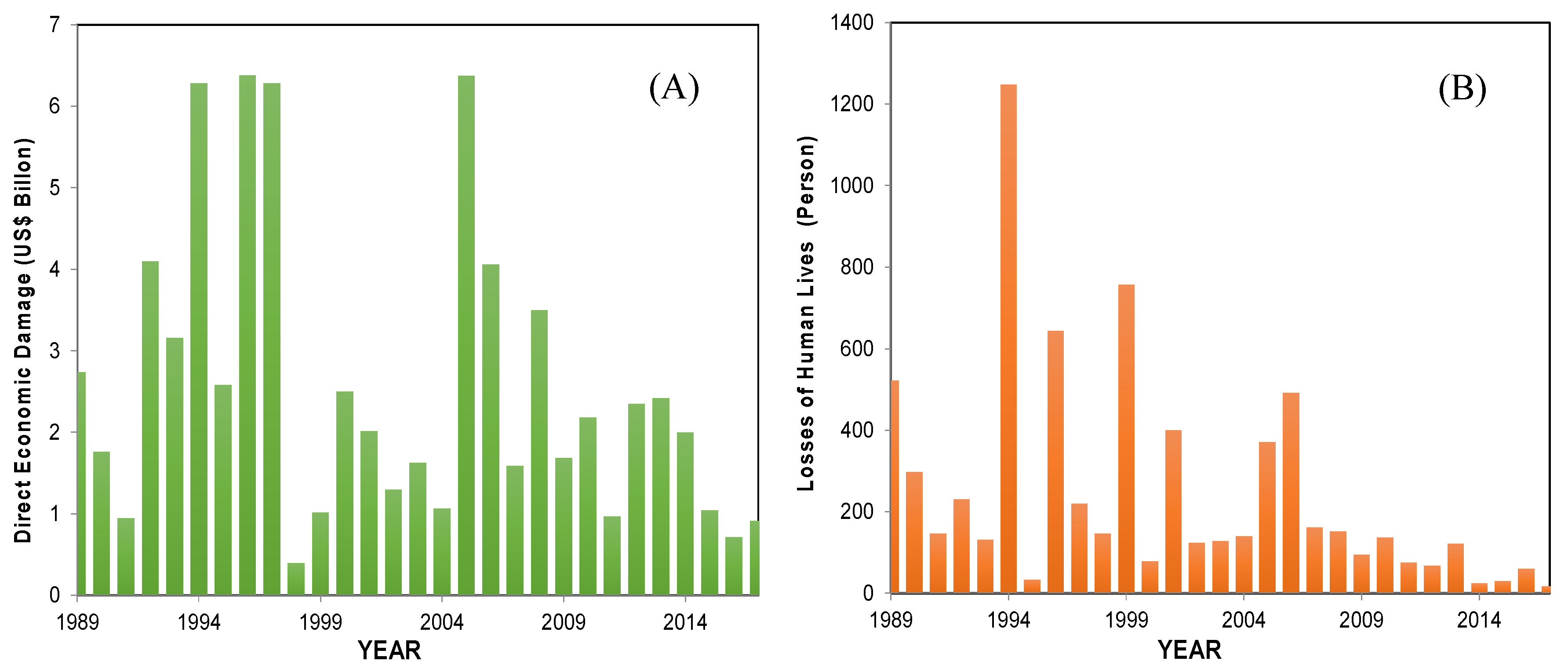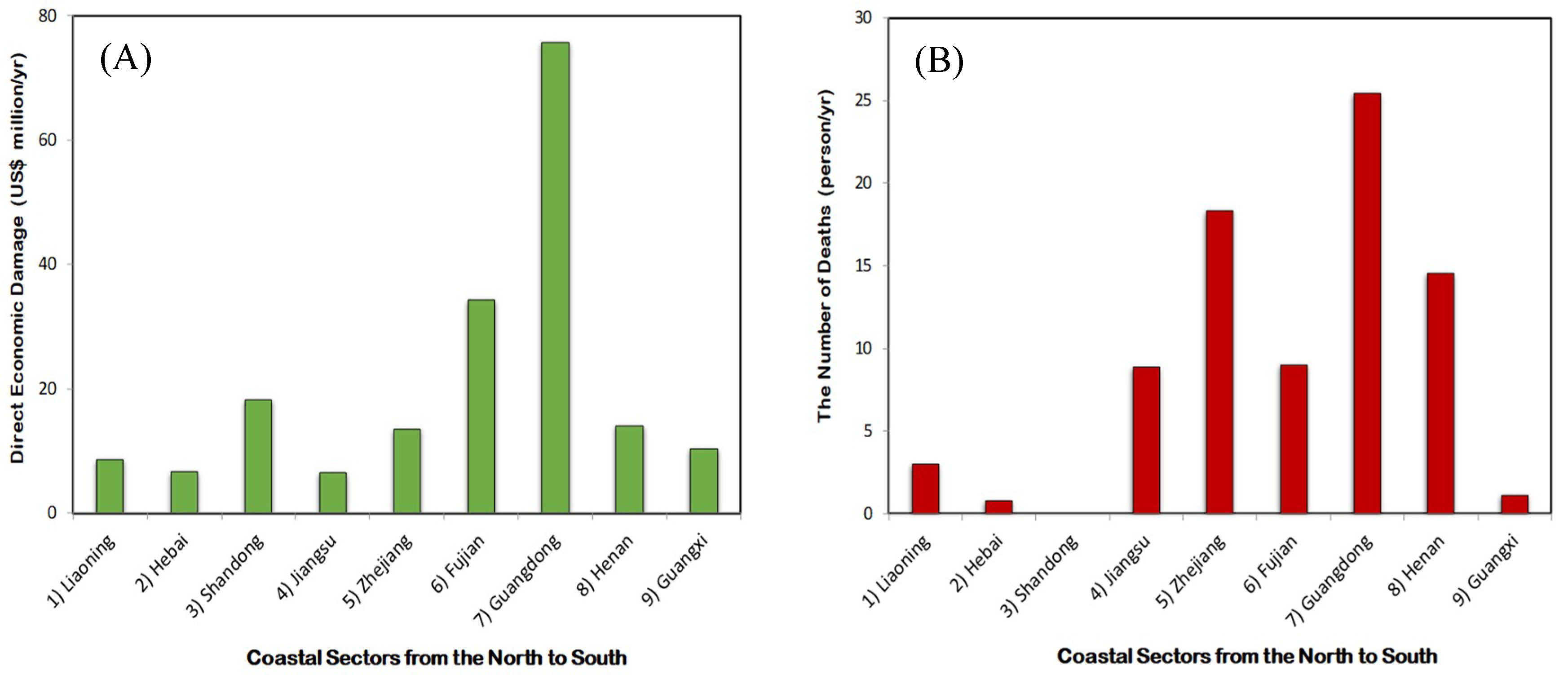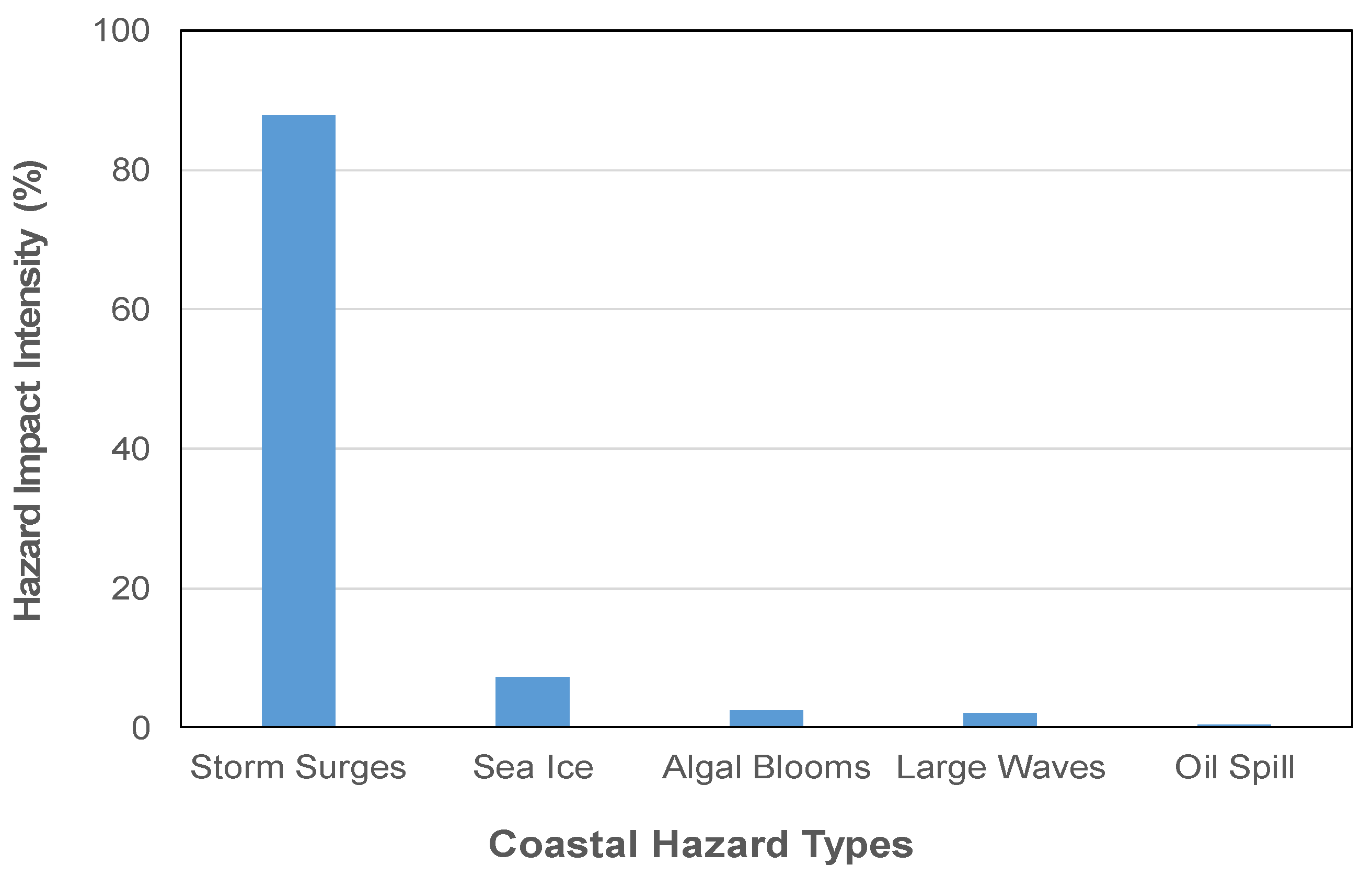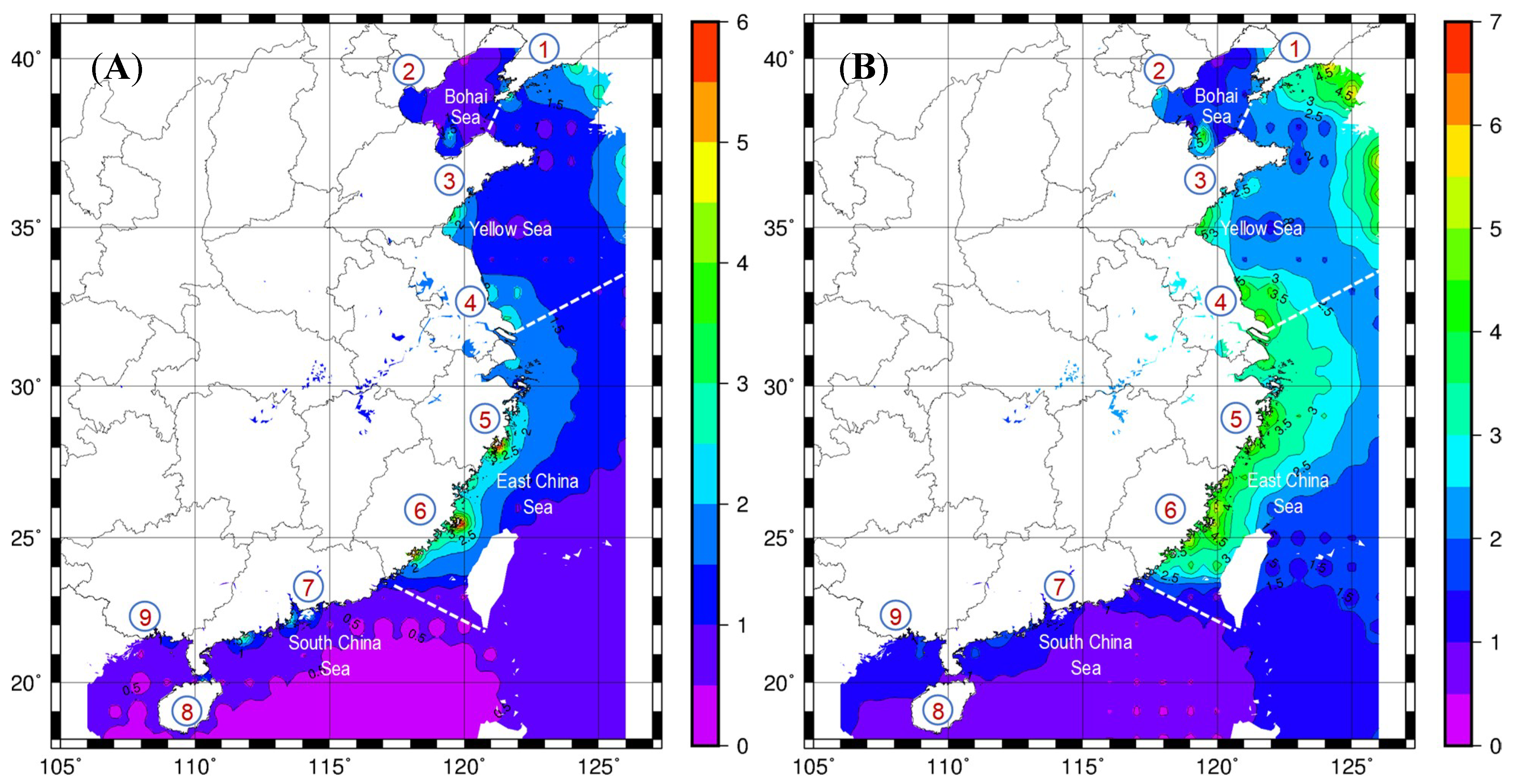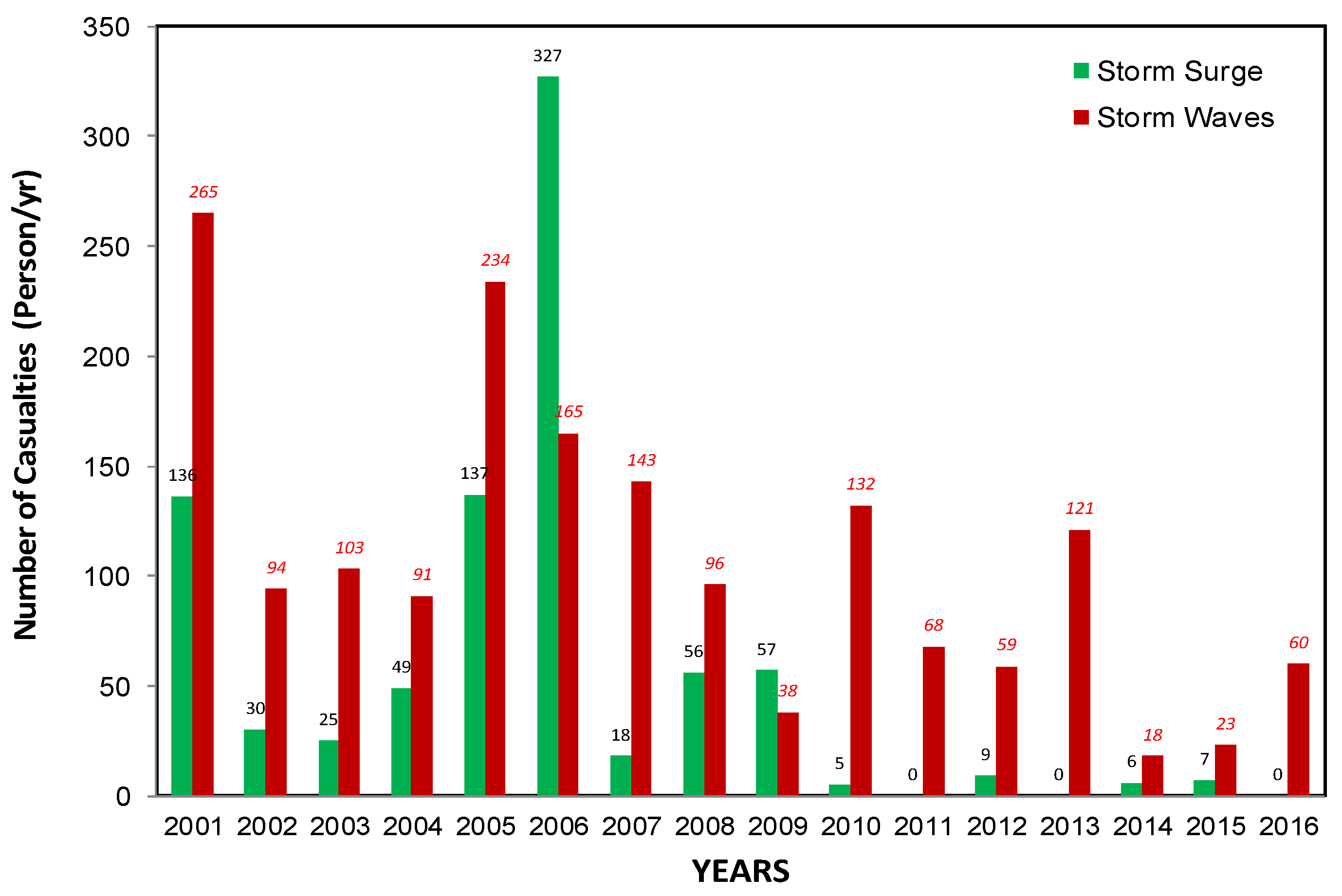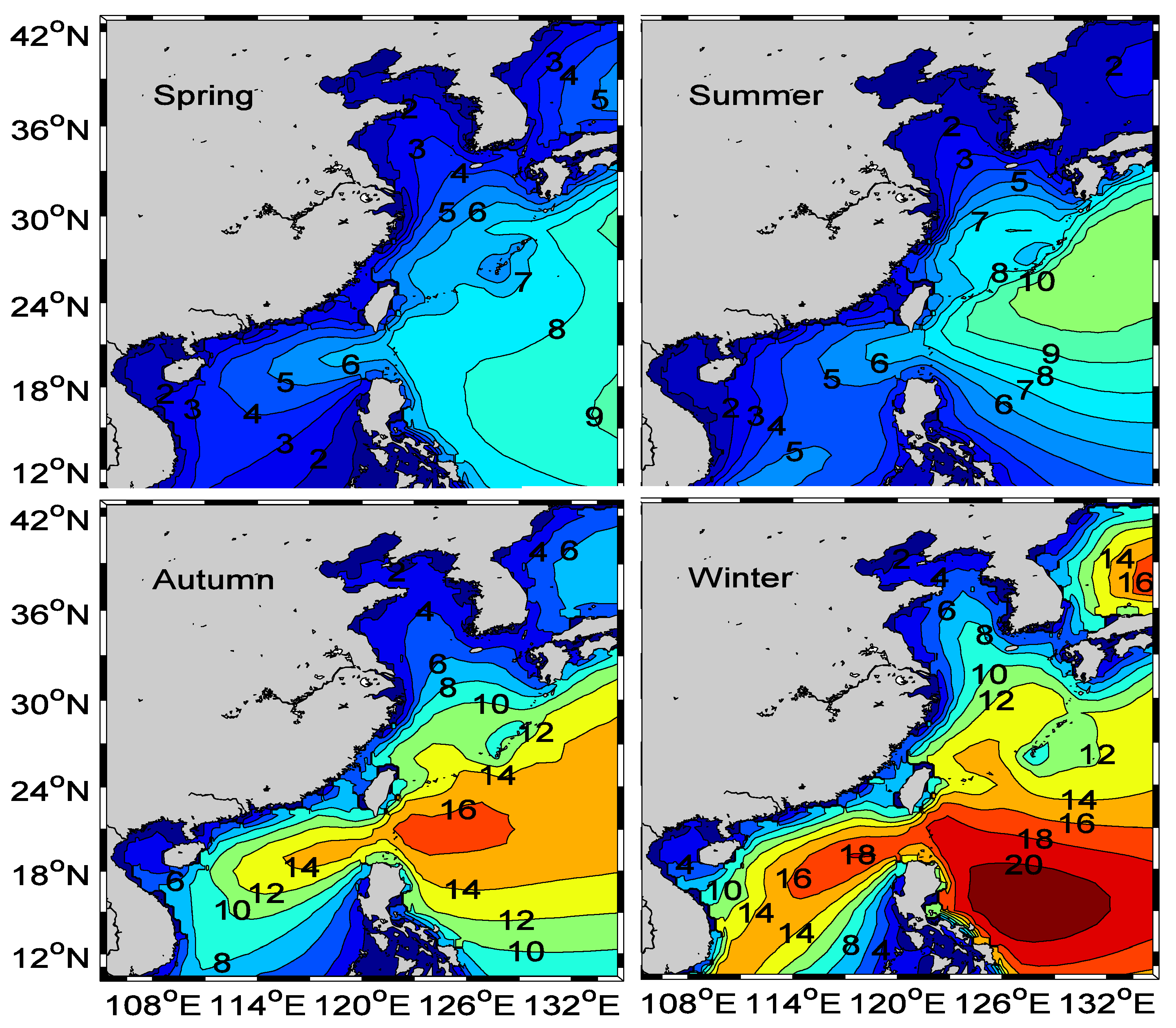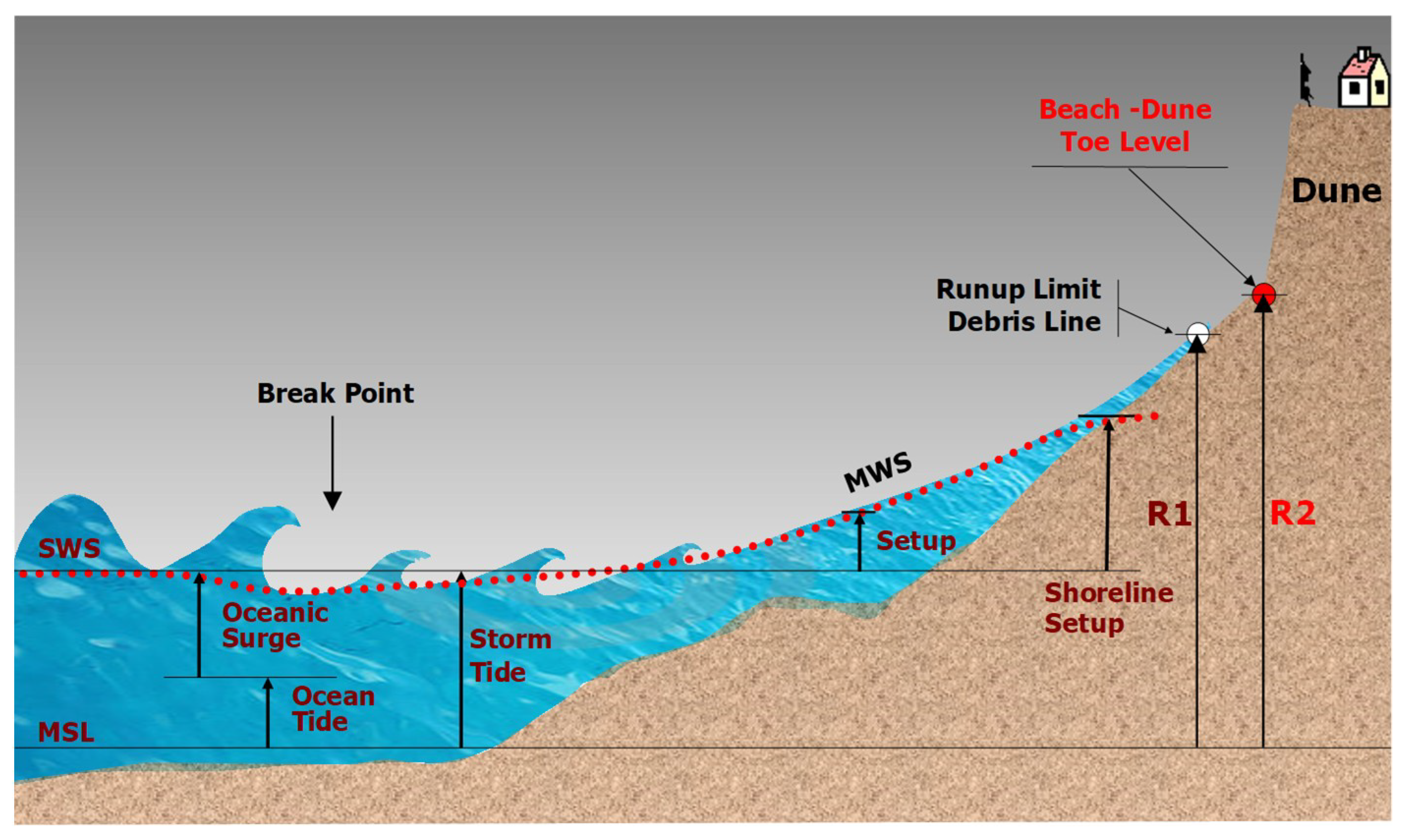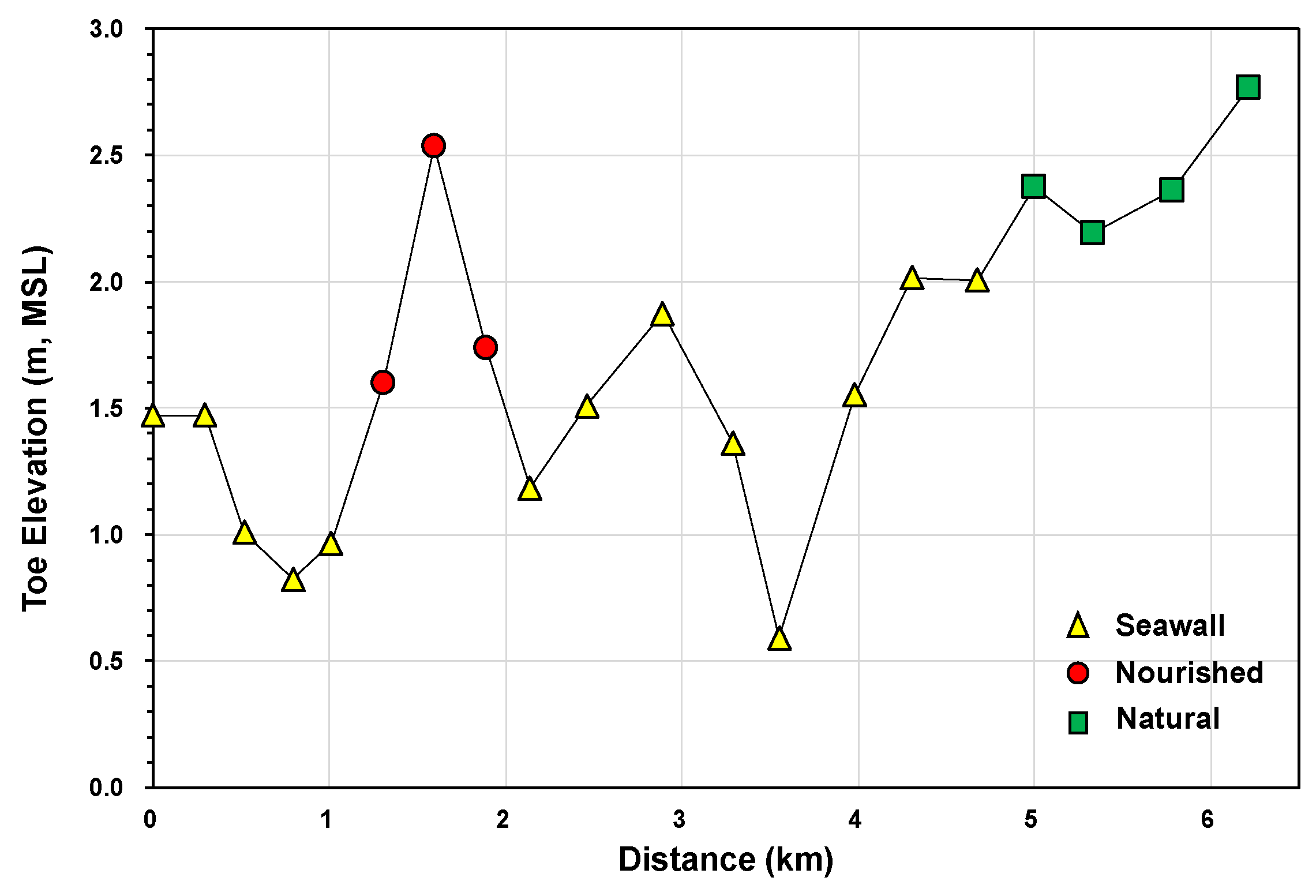1. Introduction
There is about 50% of the Chinese national population living and working along the 18,000 km mainland coast of China. Although the coastal land area is less than 14% of the territory of China, it creates more than 50% of the national wealth, 45% of the state-owned assets, 64% of the township enterprise assets, and 60% of the national social wealth [
1]. For the last few decades, the rapid economic growth in China has resulted in extensive development of the coastal infrastructure and property, excessive reclamation of coastal land, huge expansion of coastal ports, and a significant increase in the coastal population. Furthermore, there are also increasing pressures to further develop Chinese coastal areas for residential, commercial, tourism, and recreational purposes.
Tropical cyclones (TCs) strike with higher frequency and intensity in China than any other country in the world [
2]. There are about 6–10 landfall TCs in a typical year on the coast of China. TCs that strike East and South-East Asia have intensified by 12–15%, with the proportion of storm categories 4 and 5 having doubled or even tripled [
3,
4]. The high landfall frequency and intensity of TCs is due to the facts that the coastline of China is oriented in the west of the northwest Pacific Basin, which has a high frequency and intensity of TCs, and furthermore the coastline is quite long and is oriented in a north–south direction thus exposing to the dominant direction of TCs. The Meteorological Administration of China maintains the Tropical Cyclone Data, including typhoon track data, satellite reanalysis data, typhoon landfall data, wind data, and rainfall data. The globally averaged intensity of TCs is projected to continue to shift toward stronger storms with an expected increase of 2% to 11% by 2100 [
5].
TC-induced storm surges are a major coastal hazard, especially in the three provincial sectors of Zhejiang, Fujian, and Guangdong all situated on the southern coast of China. The storm surge hazard on the coast of China is a regional paroxysmal one that can cause enormous loss of human lives, property, and infrastructure. The highest rate of low-magnitude surges is observed in the western North Pacific, as the coast of China has 54 surges larger than 1 m per decade [
6], and the prominent consequences from the large storm events could remain for many years. In 2014, the China Sea Level Bulletin stated that from 2004 to 2006, more frequent and higher intensity storm surges were responsible for the greatest losses of coastal property in the provincial coastal sectors of Zhejiang and Fujian, and the losses were more serious than those in the historical records. The increasing economic losses on the coast of China are also found to be associated with the rapid socio-economic development of the coastal areas; global climate change and sea level rise may also play an important role [
7,
8]. The storm surge hazard has resulted in severe damage to the Chinese coastal economy and heavy human losses. For example, on 21 August 1994, TC (No. 9417) hit the coast of Zhejiang Province, resulting in 1248 deaths, the flooding of 189 coastal towns, affecting 22.8 million people, and causing a direct economic loss of US
$2.5 billion [
9]. In the East Asia and Pacific region, the coast of China is expected to be a high-risk area due to the future storm surge hazard. Even though numerous studies were undertaken to investigate TC-induced storm surges on the coast of China, the great impacts of storm waves and their elevated mean water levels were often not considered in the modeling of coastal inundation [
10].
TC-induced coastal erosion is another major hazard on the coast of China. About 46% of the Bohai Sea coastline, 49% of the Yellow Sea coastline, 44% of the East China Sea coastline, and 21% of the South China Sea coastline have severe erosion problems [
11]. The shoreline retreat in low-lying areas around the Shandong Peninsula is greatly accelerated, and a maximum shoreline retreat of 300 m/year is found around the mouth of the Yellow River. This has resulted in Chinese national land losses of 14.3 ha and economic losses of US
$50 million per year [
12]. Even though several types of physical processes-based numerical models, such as X-Beach, have been used to estimate coastal storm erosion rates on the coast of China [
13], how to predict long-term shoreline changes especially for some of the muddy coastal regions remains unsolved.
On the basis of the long-term and most recent coastal hazard data collected by the State Oceanic Administration of China (SOA) from 1989 to 2017, this study is undertaken to systematically investigate the major coastal hazards and their unique drivers, determine the impact of storm waves and different timescales of mean water levels on the coast of China, and finally present a simple two-parameter conceptual model for the assessment of coastal inundation and erosion hazards on the coast of Yantai, China.
2. Study Area
The study area is the mainland coast of China, which consists of eight provincial coastal sectors in the Bohai Sea, Yellow Sea, East China Sea, and South China Sea (see
Figure 1). In addition, one provincial Island of Hainan (8) is also included in this study. In considering the geomorphic characteristics of the coastline, Hangzhou Bay, which is located on the dashed red line in
Figure 1, divides the mainland coastline into two geomorphic regions: southern and northern. In the northern region of the coast, some of the high mountains and hills and the Shandong Peninsula extend to the coastal zone, but most of them are very flat and low-lying (e.g., the Yangtze River Delta region) with an average level of 2–5 m above mean sea level (MSL) and are protected by seawalls or embankments. In the southern region of the coast, the coastline is more irregular, rocky and steep, more than half of the southern coastline being predominantly rocky, and most of the remainder is sandy and muddy. The provincial coastal sector of Shandong (3) has more sandy beaches than the other coastal sectors.
Astronomic tides on the coast of China are variable in type and amplitude [
14]. Tides in the Bohai Sea are predominantly semidiurnal although they are also irregular semidiurnal or irregular diurnal in several coastal regions, while tides in the Yellow Sea and East China Sea are mainly semidiurnal with a large and variable tidal range. In the South China Sea, tides are more complex, varying from diurnal to semidiurnal. The spring tidal ranges (Ω = 2.5–5 m) in the middle coastal sectors of (4)–(6) are higher than those (Ω < 2 m) in the other coastal sectors of (1)–(3) and (7)–(9) [
15].
Wave patterns on the coast of China are determined by monsoon wind patterns, wind blowing fetch, and swell penetration. In general, northerly coastal waves prevail in the winter, moving progressively southwards from the Yellow Sea and spanning the entire mainland coast of China; southerly coastal waves are dominant in the summer, moving northward from the South China Sea, and there are no prevailing waves when wind directions are variable during monsoon transitional periods [
14]. Significant wave heights and periods (
Hs = 1.0–1.2 m,
Ts = 5–7 s) in the southern coastal sectors of (5)–(8) are generally larger than those (
Hs < 1 m,
Ts < 4 s) in the other coastal sectors of (1)–(4) and (9) [
16].
TCs on the coast of China generally develop from the north-western Pacific, and there are about 6–10 landfall TCs in a typical year, with one to two additional bypassing storms coming close enough to the coast of China to cause significant damage [
17], e.g., three extreme storms in 1956, 1969, and 1994 resulted in more than 7400 human casualties. The historical best-track typhoon datasets are maintained by the Tropical Cyclone Data Centre in the China Meteorological Administration, which provides six-hourly typhoon locations and intensities [
18].
4. Inundation-Erosion Model
Coastal inundation and erosion hazards often occur at high storm tides during coastal storms. Storm-induced large breaking waves arrive at the beach and generate large volumes of high kinematic water that runs up onto the beach high enough to attack the beach berm and dune toe. This causes sand to be taken from the dune toe because of the down-rush mechanism in the swash zone. When the eroding dune slope becomes larger than the equilibrium dune slope, the dune front collapses and lumps of the dune sand are transported into the surf zone by the high-speed down-rush water. These physical processes continue to further erode or inundate the dune–beach system until the storm waves become smaller and the storm tides lower.
A wide range of coastal field data on beach–dune profiles and sediment grain-size distributions of more than 200 sandy beaches in Australia were collected by You et al [
21]. They found that the sand dunes of their surveyed beaches were generally eroded when the dune toe elevations were less than 3.0 m above MSL. Their finding was further confirmed by the convincing field data that were collected in a 500 m test section of the long and straight Lighthouse Beach on the coast of New South Wales. The high sand dune sat on a rock platform at both the north end and the middle of the test section, while the sand dune sat on sand bed at the south end. It was observed that the dune toe at 3.16 m above MSL at the north end was well protected by dune vegetation and no erosive evidence was found, but the dune toe at 2.32 m above MSL in the middle section and the dune toe at 2.64 m above MSL at the south end of the test section were all eroded.
In this study, the simple conceptual model [
21] was applied to assess both coastal inundation and erosion hazards on the coast of China:
where
R2 is the dune or seawall toe level for the assessment of coastal erosion hazard or
R2 is the dune or seawall top level for the assessment of coastal inundation hazard,
Rt is the tidal level,
Rs is the storm surge height,
Rw is the wave setup height,
Rr is the wave run-up height,
Rh is the mean sea level (MSL), and
R1 = (
Rt +
Rs +
Rw +
Rr +
Rh). All parameters in Equation (2) are defined and illustrated in
Figure 8. Rather than indirectly measuring different mean water level components in Equation (2) [
22,
23],
R1 and
R2 can be directly measured in the field [
21,
22].
The two-parameter conceptual model in Equation (2) may be used to assess: (1) coastal inundation levels
R1 with different return periods, e.g., dune–beach will be inundated when the dune or seawall top level
R2 is lower than the wave run-up elevation
R1; (2) dune–beach stability, e.g., dune–beach system will be unstable when
R1 >
R2; and (3) shoreline setback horizontal distance ∆
X when
R1 >
R2, and ∆
X can be directly derived from Equation (3) as
where ∆
z = (
R1 −
R2) and tan
β is the mean beach slope above mean water level. Equation (3) is similar to the Buun Rule [
25], but it also considers small timescales of mean water level components such as storm tide and wave-elevated mean water levels. Therefore, Equation (3) may be considered as a more general model than the Buun Rule for the estimation of shoreline setback distance.
As an example, the conceptual model in Equation (2) was applied to assess the dune–beach stability of Yantai Beach in the coastal sector of Shandong (3). Yantai Beach is a 7 km long popular swimming beach, with sediment grain size of
d50 = 0.2–0.25 mm. Most of Yantai Beach is protected by vertical seawalls, one swimming section is artificially nourished to overcome beach erosion problems, and the last beach section is generally stable with a natural sand dune. The nearshore tides are regular semidiurnal with a tidal range of 1.64 m.
Figure 9 shows the spatial variation of dune or seawall toe elevation along the 7 km beach, which is averaged from the field data collected monthly from December 2017 to December 2018. The seawall toe elevations are shown to be
R2 ≤ 2 m, and some are even lower than the high tide levels resulting in beach inundation. The nourished beach section with dune toe elevations of 1.6 m ≤
R2 < 2.6 m was found to have some erosion problems, while the stable beach section has the dune toe elevations of 2.3 m ≤
R2 < 2.8 m. The mean dune toe elevation of the stable beach section is estimated to be
R2 = 2.7 m, which is averaged from all data points collected monthly from December 2017 to December 2018. The estimated value of
R2 = 2.7 m in this study is slightly lower than
R2 = 3.0–3.5 m proposed [
21]. This difference may have resulted from inaccurate MSL datum, the limited field data used, or different dynamical drivers.
5. Conclusions
Over recent years, the coast of China has been periodically struck by tropical cyclones at a higher intensity; the globally averaged intensity of TCs is projected to continue to shift toward stronger storms with an expected increase of 2% to 11% by 2100. TC-induced coastal hazards on the coast of China have resulted in heavy human losses and large losses to the Chinese coastal economy. TC-induced storm surges are found to be responsible for 88% of the total hazard-caused coastal economic losses (US
$2.6 billion/year) on the mainland coast of China, while TC-induced large coastal waves together with storm surges have caused heavy human losses (264 deaths/year). The hazard-caused losses to the coastal economy and the human losses are shown to spatially increase from the north to south, peak at the coastal sector of Guangdong (7), and well correlate to coastal wave power especially in the southern coastal sectors of Zhejiang (5), Fujian (6), and Guangdong (7). The hazard-caused losses to the coastal economy and the human casualties estimated in this study with the most recent hazard data are generally consistent with those of You et al [
19]. The simple two-parameter conceptual model (Equation (2) together with Equation (3)), which has not yet been testified by You et al [
19] with available field data, generally agrees with the
R2 field data collected on the beach of Yantai in China, and therefore may be considered as a more general model than Bruun Rule for the assessment of coastal inundation and erosion hazards with different return periods. Further field studies on the parameters
R1 and
R2 are urgently needed.
